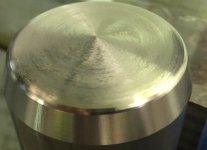I am entirely new to the finishing game.
After running a couple test runs over two tapered surfaces (center to edge ~20 thou taper - steep on the side taper) on a 2" round test piece, the surface is smooth to the touch, but appears pockmarked with random "splotches" for lack of a better technical term.
First run was at 5000 rpm at 80ipm with a 4 flute, 1/2 carbide ball endmill. The second at 5000 and 40 ipm with an indexed, two flute 1/2 ball. (0.004 chipload and 0.005 stepover.) Same problem with both tools. The problem is drastically worse on the shallow slope on the top of the workpiece.


I am running this on a beefy Okuma VMC 4020 with 4 coolant spigots hitting the mill.
All suggestions greatly appreciated!
Bruce
After running a couple test runs over two tapered surfaces (center to edge ~20 thou taper - steep on the side taper) on a 2" round test piece, the surface is smooth to the touch, but appears pockmarked with random "splotches" for lack of a better technical term.
First run was at 5000 rpm at 80ipm with a 4 flute, 1/2 carbide ball endmill. The second at 5000 and 40 ipm with an indexed, two flute 1/2 ball. (0.004 chipload and 0.005 stepover.) Same problem with both tools. The problem is drastically worse on the shallow slope on the top of the workpiece.


I am running this on a beefy Okuma VMC 4020 with 4 coolant spigots hitting the mill.
All suggestions greatly appreciated!
Bruce




